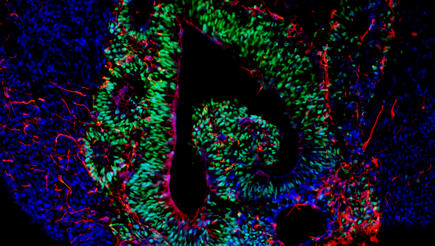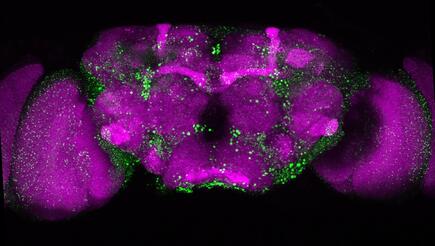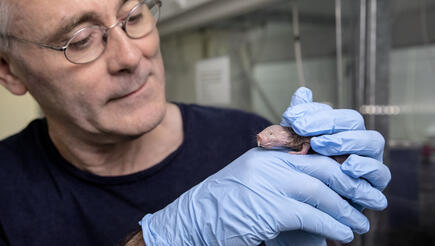Helmholtz Association
Tackling science's great challenges together
The mission of the Helmholtz Association’s members is to solve the “grand challenges facing society, science and industry.” The Max Delbrück Center is one of 18 Helmholtz Centers in Germany working in the field of health research. Our mission is to better understand how to combat widespread chronic diseases in the future. To achieve this goal, the Max Delbrück Center works closely and strategically with the five other major institutions participating in this research field.

Our Research Program
Biomedical research within the Helmholtz Association is organized into research programs. Scientists from Helmholtz Centers involved in the research field health study causes and emergence of complex diseases and develop new strategies for early detection, prevention, diagnosis and therapy.
Scientists at the Max Delbrück Center research the biological foundations of humans in order to understand diseases even better and to prevent illnesses. They want to understand what controls or disturbs the natural balance in individual cells, in an organ or in the whole body. They analyze the human system; the biological basis of life from its most elementary building blocks to cross-organ mechanisms.
This knowledge offers the opportunity to effectively prevent diseases, to diagnose them on the basis of the first cell changes, and to stop the progression of diseases with tailored therapies before they can cause major damage to the body. This is what what our scientists want to achieve in the research program "Systems Medicine and Cardiovascular Diseases".
Inspired by Challenges
What are the major challenges of our time? And what solutions are we developing at Helmholtz with our interdisciplinary research? Discover our challenges:
Further challenges with our participation
Preparing the city of the future for the climate of the future
The Helmholtz Climate Initiative is helping cities to become climate-neutral while adapting to the consequences of climate change.
Understanding Covid-19 and learning from the pandemic
We research Covid-19 extensively to help sick people and stop the spread of the virus. This knowledge also accelerates prevention and will enable us to identify other dangerous pathogens more quickly in the future.
Defeating common diseases
Our goal is ambitious: We want to defeat widespread diseases such as Alzheimer's, cancer and diabetes. To this end, our health researchers are developing state-of-the-art diagnostics, innovative medicines and new approaches to prevention.
Helmholtz Foundation Models Initiative (HFMI)
Helmholtz is funding pioneering work on foundation models - complex AI applications with enormous potential. Trained with data from medicine, climate or materials research, they can find new correlations and enable predictions. The Max Delbrück Center is receiving 5.55 million euros.
We are participating in the following projects:
- The Human Radiome Project
- 3D radiology data for a fundamentally better understanding of anatomy and pathology
The more accurately tumors can be localized and marked, the more successful radiation therapy tends to be. However, medicine has so far reached its limits in this respect because it has been very laborious to relate results from different imaging techniques to each other and to present them in a three-dimensional format.
Precise tumor localization and marking are just one of the many procedures that “The Human Radiome Project” will improve in the field of medical imaging. It brings together the world's most extensive and diverse collection of 3D radiological images, such as MRI and CT scans, in a foundation model. This gives researchers deep insights into human anatomy and pathology as well as an overview of the entire spectrum of radiological information. “The Human Radiome Project” not only improves personalized medicine but also enhances diagnostic efficiency by reducing the need for manual labeling of complex medical images.
Participating Centers: Deutsches Krebsforschungszentrum (DKFZ), German Center for Neurodegenerative Diseases (DZNE), and Max Delbrück Center.
- Synergy Unit
- Developing, deploying, and connecting foundation models
While individual projects focus on their specific issues, a Synergy Unit concentrates on overarching questions relevant to all participating projects. For example, it addresses concerns such as model scalability or training with datasets. However, it's not just about exchanging solutions; it's primarily about advancing research on foundation models across disciplines as rapidly as possible. Thus, the Synergy Unit ensures a long-term impact of the Helmholtz Foundation Model Initiative for the benefit of the general public.
Participating Helmholtz Centers: Deutsches Krebsforschungszentrum (DKFZ), Helmholtz Munich, Forschungszentrum Jülich, and Max Delbrück Center.
- AqQua
- AI model for aquatic biodiversity
Life in the water plays a crucial role in the Earth's climate. Plankton in particular binds large amounts of carbon from the atmosphere. Climate change is altering plankton ecosystems and affecting carbon export and food resources in the ocean. Despite its enormous importance, we know surprisingly little about the abundance of most plankton species. There are also major uncertainties in estimates of global marine carbon export. Every day, researchers around the globe take millions of plankton images using a variety of instruments. Distributed pelagic imaging enables comprehensive monitoring of aquatic life down to the bottom of the deep sea.
AqQua will combine billions of such images to develop the first fundamental pelagic imaging model that can be used for global monitoring of plankton biodiversity, ecosystem health and carbon flux. In this way, we will support decision-making in times of global change, particularly with regard to new technologies for removing carbon dioxide from the atmosphere.
Participating Centers: Forschungszentrum Jülich, GEOMAR, HEREON, Max Delbrück Center
- VirtualCell
- A Foundation Model for Cell and Tissue State Across Health and Disease
It is a long-standing vision to create a digital twin like replica of a cell. This would enable not only insight into the plethora of ongoing complex cellular processes but also effect prediction under perturbations such as disease or drugs. Building upon recent advances in high-throughput genome sequencing and imaging combined with generative AI, the VirtualCell project aims to tackle this ambitious challenge.
The project will develop a multimodal baseline model trained on extensive single-cell multi-omics and spatial data to provide a comprehensive representation of cellular states and interactions. The model will be applied to a range of novel clinical tasks by adapting it to disease samples from biomedical partners. By advancing cellular modeling, VirtualCell is poised to achieve breakthroughs in disease pathology, drug development, and patient stratification, and to significantly improve biomedical research and healthcare outcomes.
Participating Centers: Forschungszentrum Jülich, Helmholtz Munich, Max Delbrück Center
HAICORE
Access to computing resources is the key for the Helmholtz AI community to accelerate innovative AI applications. The “Helmholtz AI COmputing REsources” (HAICORE) at the Max Delbrück Center provides easy and low-barrier access to dedicated GPU resources for the HFMI.
H3 Health Hub - A Helmholtz Transfer Academy
The academy is a joint program of the six Helmholtz Health centers. Together, we enable researchers, employees and aspiring entrepreneurs to successfully transfer results from lab into business.
We provide a platform for community, learning, events and collaborative projects in this field. Our partners from the regional life science ecosystems are integrated closely throughout the process.
NAKO – the German National Cohort
The German National Cohort (NAKO Gesundheitsstudie, or NAKO for short) is a joint interdisciplinary project being undertaken by the Helmholtz Health Centres. It involves the cooperation of university and non-university partners throughout Germany and a total of 200,000 study participants. Some 30,000 of these participants will undergo a one-hour MRI examination.
The Max Delbrück Center coordinates the study’s Berlin-Brandenburg Cluster, which comprises three study centers and 30,000 participants recruited from Berlin and the surrounding Brandenburg area. The Max Delbrück Center itself is studying 10,000 individuals and performing MRI examinations on 6,000 of these participants.
Overview of the Helmholtz Association
The Helmholtz Association is one of Germany’s four leading non-university research organizations, along with the Max Planck Society, the Fraunhofer-Gesellschaft, and the Leibniz Association. Its namesake is the renowned German physician and physicist, Hermann von Helmholtz. Some 38,000 people are employed within the Helmholtz Association. The work carried out at the 18 autonomous Helmholtz Centers is organized into six research fields:
- Aeronautics, Space and Transport
- Earth and Environment
- Energy
- Matter
- Key Technologies and
- Health
The scientists working in the field of health research investigate the causes and development of widespread chronic diseases such as cancer; diseases of the cardiovascular system and the lungs; metabolic and infectious diseases; and disorders of the nervous system. This work involves numerous partnerships with universities, university hospitals, other research organizations, and industry.
- Targeted funding for strategic research programs
- How does the Helmholtz Association fund its research? Who determines the research topics and monitors research quality?
The members of the Helmholtz Association receive 90 percent of its roughly €4 billion base budget from the German federal government and ten percent from the state governments. Under the Pact for Research and Innovation, the federal and state governments of Germany have ensured planning dependability by promising a continuous increase in funding.
The research centers themselves receive a third of their budget from third-party funding sources, such as the German Research Foundation (DFG), the German Ministry of Education and Research (BMBF), the European Union, and various other foundations or private donations.
Their core budget, however, comes via the Helmholtz Association’s system of program-oriented funding (POF). All Helmholtz research is organized into research programs that are reviewed every five years by renowned independent experts.













